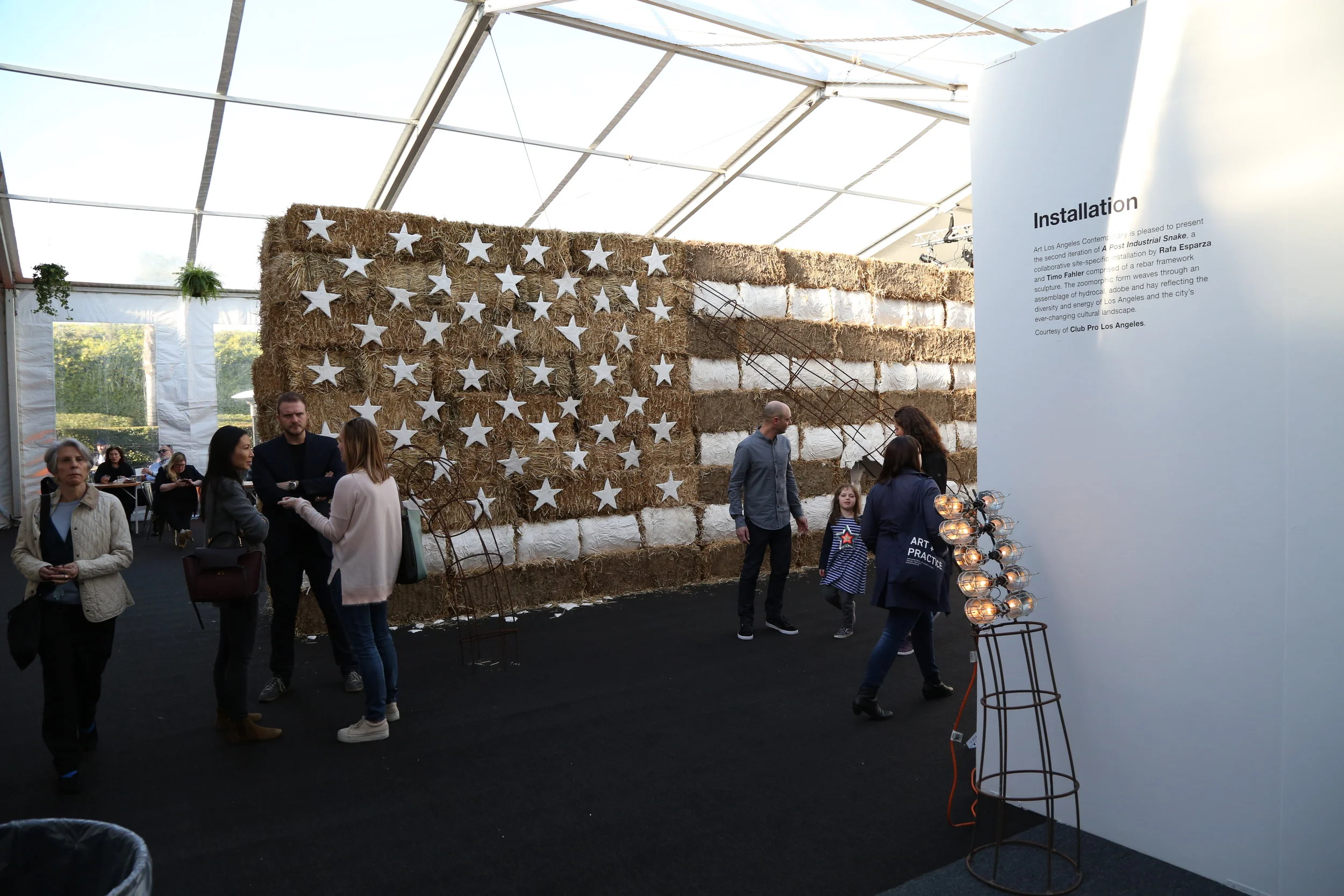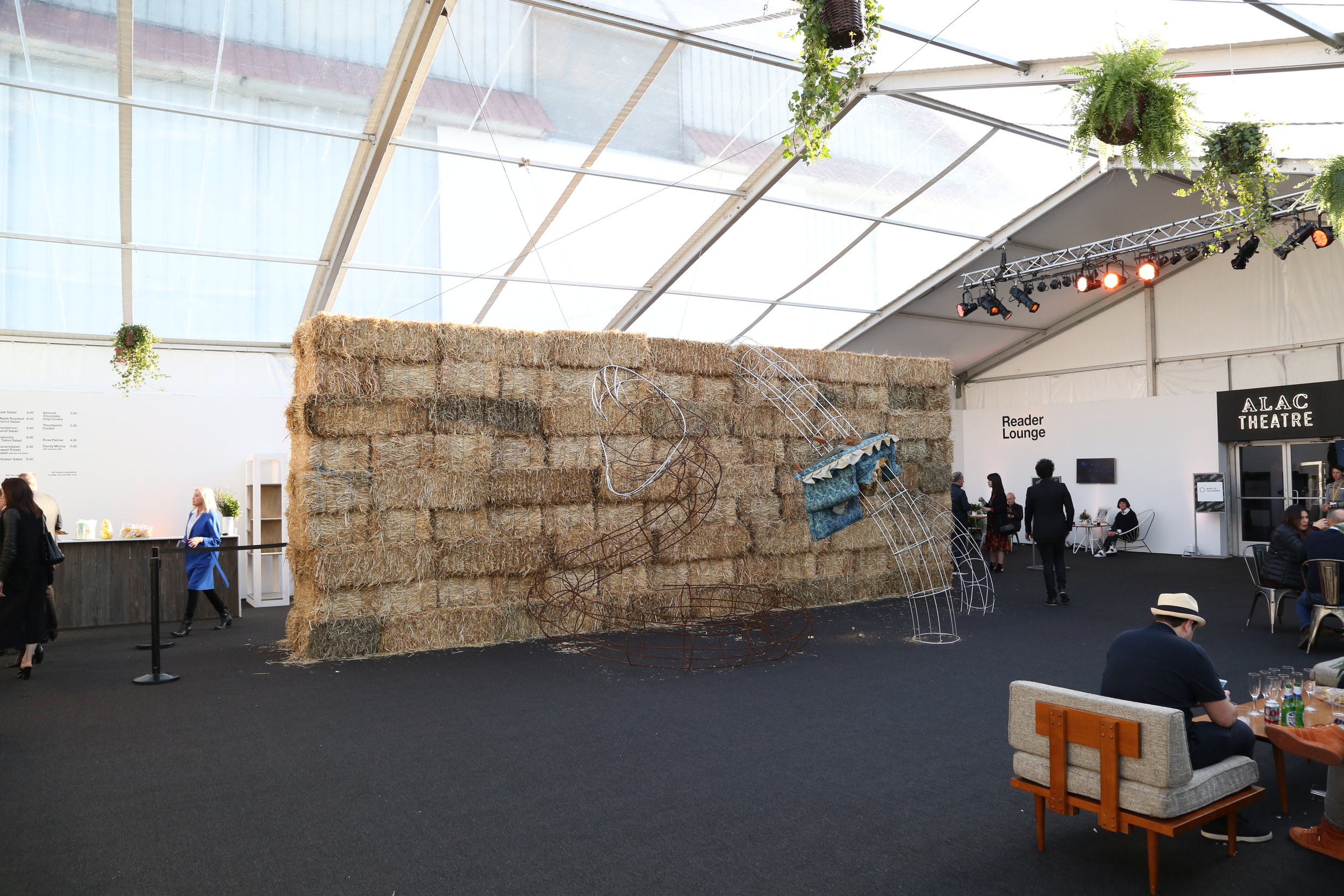









Your Custom Text Here
A POST-INDUSTRIAL SNAKE IN THE GRASS SETS THE TONE FOR ART LOS ANGELES CONTEMPORARY (JAN 26TH - 29TH AT THE BARKER HANGAR)
BY CHRISTINA CATHERINE MARTINEZ
Timing is everything. Given Western civilization’s current slide into a dangerous parody of itself, and its recent uncoupling from the postponed LA Art Book Fair and the now-defunct Paramount Ranch, the eighth edition of Art Los Angeles Contemporary looks to be energized by both crisp commerce and political dread, hopefully cut by signs of the optimism that is our West Coast birthright...
...When the fair opens this Thursday, the slippery exchange of capital will be obliquely manifested in the resurfacing of Timo Fahler and Rafa Esparza’s on-site installation A Post-Industrial Snake. The expansive sculpture takes eponymous form as an openwork rebar serpent that literally rends through the material context of its display. Redolent of both urban playgrounds and buildings-in-progress, the snake wears its themes with ease: capitalism, labor, urban renewal as conquest. That it would wend its way West seems inevitable. Visitors who may recall A Post-Industrial Snake’s previous iteration at Club Pro Los Angeles’ garment district digs will find it has been “flashed up” for the occasion with a coating of shiny chrome, but that is all the artists reveal at the moment. “From one space to the next, the work evolves.” Fahler said via phone, “In this particular case, the idea of the market, and by extension, the artist, is plated on the snake. Not just as a comment on marketability, but… perhaps also an ominous warning.”
Even as the Trans-Pacific Partnership dissolves in our Chief Executive’s diminutive palms, the global culture industry understands there are far more nuanced forms of capital at play—at times immaterial, but no less real. The snake is nothing if not adaptable. With plans to cross into more accessible public contexts, possibly shedding herself altogether and evanescing into pure performance, Fahler and Esparza’s collaborative project is cogent in concept while fully encompassing the conceptual and political complexities that unfurl with each iteration. “We’re not trying to bite the hand that feeds us,” Fahler says, “ just be aware that it is a hand that bites.”
A POST-INDUSTRIAL SNAKE IN THE GRASS SETS THE TONE FOR ART LOS ANGELES CONTEMPORARY (JAN 26TH - 29TH AT THE BARKER HANGAR)
BY CHRISTINA CATHERINE MARTINEZ
Timing is everything. Given Western civilization’s current slide into a dangerous parody of itself, and its recent uncoupling from the postponed LA Art Book Fair and the now-defunct Paramount Ranch, the eighth edition of Art Los Angeles Contemporary looks to be energized by both crisp commerce and political dread, hopefully cut by signs of the optimism that is our West Coast birthright...
...When the fair opens this Thursday, the slippery exchange of capital will be obliquely manifested in the resurfacing of Timo Fahler and Rafa Esparza’s on-site installation A Post-Industrial Snake. The expansive sculpture takes eponymous form as an openwork rebar serpent that literally rends through the material context of its display. Redolent of both urban playgrounds and buildings-in-progress, the snake wears its themes with ease: capitalism, labor, urban renewal as conquest. That it would wend its way West seems inevitable. Visitors who may recall A Post-Industrial Snake’s previous iteration at Club Pro Los Angeles’ garment district digs will find it has been “flashed up” for the occasion with a coating of shiny chrome, but that is all the artists reveal at the moment. “From one space to the next, the work evolves.” Fahler said via phone, “In this particular case, the idea of the market, and by extension, the artist, is plated on the snake. Not just as a comment on marketability, but… perhaps also an ominous warning.”
Even as the Trans-Pacific Partnership dissolves in our Chief Executive’s diminutive palms, the global culture industry understands there are far more nuanced forms of capital at play—at times immaterial, but no less real. The snake is nothing if not adaptable. With plans to cross into more accessible public contexts, possibly shedding herself altogether and evanescing into pure performance, Fahler and Esparza’s collaborative project is cogent in concept while fully encompassing the conceptual and political complexities that unfurl with each iteration. “We’re not trying to bite the hand that feeds us,” Fahler says, “ just be aware that it is a hand that bites.”